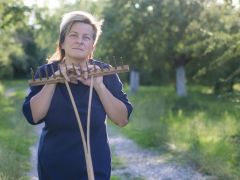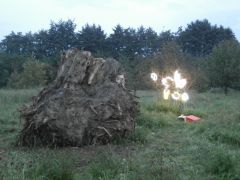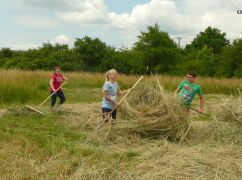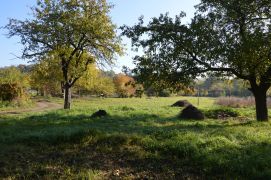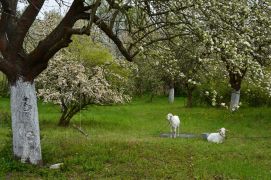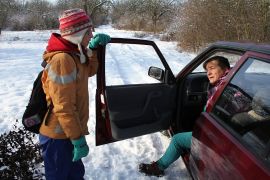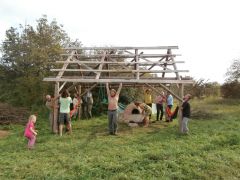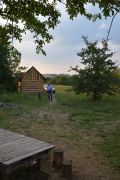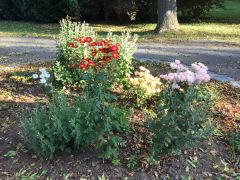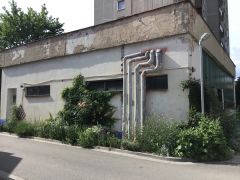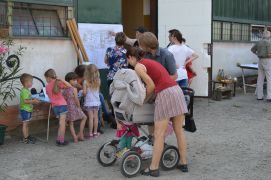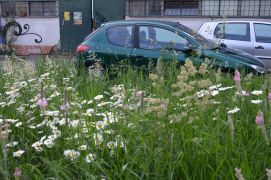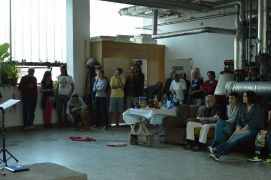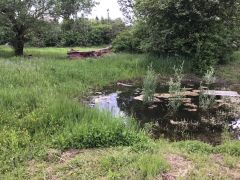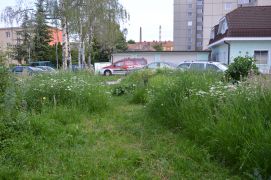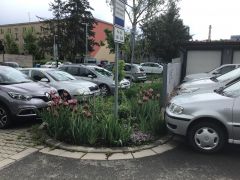Barbora Lungová is an artist who makes paintings with feminist and environmental themes. For the past two decades, she has been taking active part in the cultural, civic and political space of her hometown of Kyjov (pop. 11,000). She has an especially strong relationship with nature and the landscape, which have motivated a number of her projects focused on the caretaking of neglected spaces.
Through her former guerilla activity, she managed to bring attention to the peripheral Boršovské louky area, as well as to the small park near the artist’s studio right in the city center. The first project was run under the auspices of a dedicated association, today working as the ČSOP. The association gradually revived the meadows, and continues to maintain them – there is a forest kindergarten, and throughout the past years, the association has organized a number of events for the wider public, such as scything the meadows, cooking plum jam, or botanical walks. In all these activities, Lungová uses her aesthetic sense, gardening experience and critical reasoning, on occasion seeing these activities as a form of artistic practice. The outcome is that these places are rejuvenated in the ecological and social sense. Lungová also takes part in many other local events – she was one of the dramaturgists for the local private gallery Doma, where she has introduced many interesting young artists. She has co-organized other exhibitions and cultural events, is a member of the board which strives to create a city gallery, and has taken active part in local politics. Although today she expresses a certain fatigue from these activities, she has new projects on the go, especially in the sphere of caretaking of crucial local places. Lungová can be characterized as an artist who actively participates in local happenings, especially in the environmental and cultural spheres. She has not always made a connection between the two lives she has led, but they mutually orient each other and influence one another, and they have recently become ever more intertwined.
The epicenter of your longest-running project is the Boršovské louky, an area of meadows on the periphery of the town in the floodplain of the brook Kyjovka. Can you introduce the project’s history and aims?
I’ve always had a personal relationship to Boršovské louky. I used to paint there when I was a child. And then I also went walking there with my old boyfriend Vojta, who would say this area was like a living room for us. It was an intimate space for us, and we had a very loving relationship to it. As Vojta was teaching me to make calvados, we also often picked apples there, and we used to enjoy going there for the so-called “ostrlis”, meaning we would pick fruits there.
As late as the 1990s, there was a field which used to be mowed regularly; the locals would take walks there and the whole space was very much alive. About ten years ago, the space emptied out, and it started weeding over. I was in the midst of a fairly difficult time at school for me, and I needed somewhere to blow off steam. I told myself I ought to do something about the meadows, picked up a second-hand Japanese saw, and started cutting through the bramble, as well as pruning the trees, as they were terribly neglected. By then, the local interest in the Boršovské meadows was at an all time low. I was the only one tending the few trees and their surroundings. I talked to a few people about this, and they told me: Listen, if you want the municipality to notice that something is in fact happening, that the place might be of value to them, you have to make an association, and give your work legal standing. That is why in 2012 I founded the civic association Lúky a sady Kyjovska, which later transformed into one of the original organizations of the Český svaz ochrany přírody (Czech Union for Nature Conservation), or ČSOP. After negotiating with the municipality, they received a lease on the Boršovské louky in 2013.
In the meantime, I found out from my sister, who is a veterinarian and hears much as part of her work, that one of her classmates was looking for a place for a forest kindergarten. I didn’t know them at all, but I wondered why they are considering getting a space many kilometers away when they can get it right here. So, I contacted them, showed them the place and we agreed then and there to collaborate. And they decided to set up the kindergarten there.
It was also in this way that I started becoming ever more engaged with ecology. At one vernissage at the Doma gallery, which I was doing the dramaturgy for at the time, I met the lepidopterologist and associate professor Milan Králíček and took him to see the Boršovské louky. He told me that the place is degrading and that it’s “nothing special”. He said it would require a lot of care before it becomes home to, for example, some interesting species of butterfly, and he also informed us about other neglected localities in the region.
And it just started to snowball from there. Zuzka Veverková, a biologist and very active member of the association, has since drafted and submitted dozens of small grants for the local environs. But for me, the Boršovské louky area remains closest to my heart – I regard it as a garden where over the course of these past years I have come to know every stone. Since 2015, we were able to even find employees by means of the unemployment office. Every year, a man would stay there for a few months, cutting the grass. Another woman was employed as part of the forest kindergarten, and she for example helped take care of the goats which we had there at one time. Both are locals. And in recent years, when the money from the unemployment office ran out, I paid the aforementioned man from my own funds. And because I thought he was kind of slacking, I worked there along with him, spending about a month there.
The forest kindergarten has been going on since about 2013, and has really brought a spark of life to the space. And I also organized a bunch of events. We wanted to show the local people that this area has great aesthetic value, and also wanted to develop the perception of these qualities and remind everyone that the meadows deserve to be taken care of. We bet on the mainstream and tried to draw in those people who would not venture for some “spiritual” or conservationist event. These are attended only by individuals – for example botanical guided tours, which we once ran there. What was more popular was the workshop on properly lighting butterflies – some twenty people came for that one. For this reason we offered many diverse events. At first, we collaborated with local folklorists and organized the mowing, and some people from Šardice even came with horses, dressed in traditional Moravian costumes. We have also constructed an oven for bread making, or we cooked blackthorns in a cauldron – my grandmother managed to show me that one before she had a stroke. We used to cook up to 50 or 60 liters of plum jam. It was a big event, sometimes welcoming up to 60 people, and we stirred it for 24 hours, so a lot of people had to take part. The last great event took place about four years ago, when I convinced my dad’s and brother-in-law’s band to have a concert there. We were discussing the sound, as we had just one generator borrowed from Andreas Gajdošík, and so the guys had to wire in some car batteries. One of them lost a keyboard to a power surge — but it was a really great event.
But then interest started waning. We were trying to do all we could, put a lot of energy into it, but ultimately we realized it might be enough if we just do our own thing. We are currently going low-key – there's the kindergarten, we do offhanded hay-burning brigades, but otherwise I go there individually about once a week with the aforementioned Mr. Kroupa.
Has the locals’ relationship to Boršovské louky changed as a result of all this?
People learned to go there, and so nowadays many go for various reasons. One boy goes there for target practice, one woman takes her horses there, mothers with kids go there, dog-walkers, families make barbecues, kids go there to play. I am happy that more and more people like the place and go there. There is a flooded field just beyond the meadows, and as the skating rink was closed last winter, about thirty kids would go there to skate.
How does your association function?
We each have our particular roles to play, but sometimes they overlap. The kindergarten is being run by Martina Stávková who is finishing a Bachelor of Psychology, and it is currently her main source of income. The previous director was also a member of our association. But when there is, for instance, a need to work on the fields, they also come. We also take care of other areas of the landscape, but not as often. Zuzka Veverková writes up grants, which sometimes yield a few tens of thousands of CZK per year per locale; the money coming from regional sources, the ČSOP, as well as the Ministry of the Environment. Farmers mostly do this. There was one man working with us last year, but then he left, so that meant more work for us. Whenever someone had trouble keeping up, the rest of us went there in our free time and raked the area, often without pay. The proportion of volunteer and paid work is very similar to that of the art world. For example, when you are writing a ČSOP grant, there is no chance that you, as the applicant, will be in any way personally rewarded. And there is not much you can do with the money you do get. Volunteer work is the name of the game.
Did the coronavirus pandemic change anything?
Not much has changed. The kindergarten was closed in the spring, at the time of the strictest measures. You know what has changed? More people go outside now. Not only to the meadows, but there are more people in the landscape in general.
What are your plans for the future of Boršovské louky?
I would like to feature something a bit more artistic there. I can imagine some interventions, not really sculptural as the space is quite small, but something which would resonate. Once I brought a lady there who was in Brno as part of an exchange program from Stuttgart’s Gedok art center. She made neon objects, it was similar to the installations of Pavel Korbička. She hung them on trees and it was very nice, they fit in beautifully. It would be great if we could do two or three residencies there over the summer, like the XY Gallery in Laškov does. I feel I would like to organize this in the future, but I have so far lacked the energy. And as the space was at first terribly derelict, the first ten years were simply about making it into a garden.
You not only take care of the meadows …
I have acquired a field of half a hectare just above the meadows in order to save the unique butterfly population which lives there. Later, I bought another sliver of land in order to gain access to the first plot. I planted trees and roses there, and wish to make an artistic project which would be part of my dissertation work, but I don’t want to say too much about it yet. I find great inspiration in my current passion for irises. They have an almost infinite range of cultivars which were often bizarrely named by their original creators, the names nowadays often evoking very different meaning. There is often the word gay (originally meaning happy), or there are sexist labels (first girlfriend, perfect wife, cheap date). With their help, I would like to make a widely accessible “queer garden” called The Rainbow Garden.
I am getting to the point where I no longer think explicit representation of queer identity makes sense. Contemporary feminism is ever more grasped through its relation to inhuman or more-than-human agencies, from geology, to plants, to animals, and there is an emphasis on caretaking, whether that means caring for the landscape or its living beings. So, I thought this would be a very logical combination.
The question is whether it might become a target for vandalism. I also have to prevent the local pigs from eating the tubers. I don’t want to raise a fence around the whole space, as that wouldn’t make sense. So far, I have some mesh around it, and have already planted the peonies. It is sunny there, very dry, so I will have to work within these constraints. But that’s fine. I have been wandering through steppes and meadows for years, watching what grows where, and collecting the seeds. I have some experience and know what will thrive where.
You’ve started another gardening project right in front of your studio.
It might seem silly, but I consider it very important. The studio is basically an old boiler room in the city center with five panelák houses from the communist times right next door. In 1989, they demolished a whole street of cottages to make way for them. When I came there, it was full of parks. I adopted the small space, and started making a classic wildflower meadow with daisies and cornflower. Then however, they built two parking lots in their stead. I couldn’t prevent it, even hosting an informative afternoon with the locals and printing posters of the plans, so they would know what’s going to be built there, didn’t help. The city at that time did not communicate anything to the public as to its construction and development, and this is something which we eventually did manage to change. The municipality now discusses with the public much more, although they still often don’t give a darn.
At least I managed to propose green strips of soil, and that’s where I now have the blooming garden beds. I started expanding them among the cars. I use the irises and other plants to wedge us into the parking lot like that. I find it cool what many guerrilla gardeners in the United States do, especially Afro-Americans. I just saw an interview with one of them, who said that in order to change a community, you have to change its soil. I find that beautiful. This person is making wonderfully diverse green strips in public space – from planting chard, sunflowers, to vines and pumpkins. It is magic for me when someone can change a space into a beautifully growing garden. It is also interesting that they consider their patch and soil much like a painter uses a palette and canvas.
I was always very frustrated how much the space around my studio had changed. From a decrepit park with great potential into something wholly horrid. And so, I used to walk by it, fuming, and asked myself: Why? I’ll just wedge some beauty into what remains of it. The irises are beautifully coming into bloom now among the cars, and that makes me happier than when I am working on a canvas, and I think it makes more sense too.
Can you speak about some other activities you do in Kyjov?
The city hosts the small Doma gallery, founded thirty years ago by the Ježov family. I liked them very much since I was a child, and I had played there while a kid at vernissages. Around 2006, it started becoming too much for the owners, and they were planning to close down. I tried to convince them not to do it and started helping them out with exhibitions. I was networking them with various people and this eventually turned into collaboration, which sort of stopped four years ago, as it was becoming too much work for me. I brought a lot of people from FaVU, also from Prague. For example Igor Korpaczewski, Jan Merta, Kurt Gebauer, and the younger generation included Jakub Tajovský, Petr Nápravník, Jiří Staněk, Břetislav Malý, Denisa Krausová. This was a big part of my work, and I was doing it for a very long time.
The Doma gallery is small, but over the past three decades, there have been calls to found a city gallery. This would have to be a professional project with its own art collection, library and other functions. The initial idea came from Jiří Dunděra, a retired physician and local publicist. He approached me again this year to prompt us to start working on this more, so we created an informal association, calling ourselves the “preparatory group.“ We formulated our vision of how the gallery might best work and we presented it to the municipal board. Some deputies were proposing we collaborate with the project of Roman Buxbaum (the curator of Miroslav Tichý), who wants to develop the building where Tichý formerly had his studio. But for various reasons we decided that we didn’t wish to follow that path. So, we will see where it will go, because such a city gallery would need a budget of about two to three million CZK. But the municipality currently still seems interested in the overall idea.
I am also involved in local politics, and since 2014 I’ve been a member of the municipal board and member of committees on the topics of environment and international relations. My input into politics is no longer what it was at the start, when me and my brother-in-law were the only ones in the opposition, so we had to be very active. Nowadays, there are six of us, and I have taken a step back. I have become a bit more placid, and I don’t want to rile much conflict.
I also occasionally open my studio to the public. During the Open Studios event, I opened mine as well. I also organized concerts there, and even a theatre performance, because it’s actually a really big hall. It was part of the amateur theatre festival, and I arranged it with the organizer to stage one play which was just begging for it.
How would you characterize the general cultural happenings in Kyjov and its surroundings?
I’m not really missing anything here. Many people who are involved with culture say that nothing much happens in Kyjov, but in fact very many people are doing very cool things. Three years ago, Alena Truschingerová started organizing the Kyjograf film festival. The city boasts an amazing cinema with a panoramic, wide-angle screen. They are very good at it, writing grants and getting good money, so they work at a very high standard. Then we have the legendary club Jančovka which was founded in the 1960s as Mlatklub. Kyjov has always had a strong rock scene, and there was even a publication recently put together by Matěj Černý, featuring interviews with all the bands which very active here over the years. There were about a hundred of them. People connected with the club organized festivals of Kyjov’s singer-songwriters, they feature techno, DJs, Jazzklub organizes jazz festivals and concerts. The club is not very much used nowadays, as it is not in any adequate state. A few years ago, we managed to convince the municipality to buy it; so far, they’ve managed to renovate the windows and now we are discussing whether the city is willing to really invest a few million in order to make it usable. There are a few organizations gravitating around Jančovka. The civic society is very developed in Kyjov and grassroots culture is very vibrant.
However, our group of people working in the arts does think that official culture organized by the municipality could be doing a better job. Our city’s cultural center is going for the mainstream. They want to make a profit, and that is why they have performances with famous actors from TV, or stage a concert here and there which will be sold out. Some employees at the Cultural Center are doing amateurish work, I think. For example, there is a city gallery which has a few meters squared, is architecturally atrocious, has a minimal budget, and they organize student exhibitions and feature “special artists”, or what to call it. What can I say?
The city Cultural Centre in Veselí nad Moravou has a different way of doing things and they have a great program. The local gallery there is looking good. It is a big and beautiful space, although they don’t really have any dramaturgical angle, despite the fact that the woman who works as producer there has a degree in theatre. But they do things as best they can. We also used to have external exhibitions there, but maybe just two to three a year, because there was no space to establish a coherent dramaturgical approach.
My great friend Tomáš Prusenovský, who however has recently moved away, formerly worked for the Vrbas museum in nearby Ždánice. He started organizing the Ždánice plenaries, where he would initially invite former and current students from the Zlín vocational art school, because they used to go there for panel discussions, and he wanted to bring it back. Petr Dub was one of the guests, for example. Then Tomáš once saw a land art exhibition and he asked me whether I might know some people. Three years ago, I invited Jakub Orel Tomáš, as well as some graduates of Jan Ambrůz. It was a nice symposium. And Jakub had some great events in the forest. There were about five or six plenaries, and they made some nice exhibitions throughout the year. Now Ondra Homola has taken over, but I must confess I haven’t been following it all that close, and plus there was Covid.
But otherwise, not much happens here. I'd rather not talk about the gallery of fine art in Hodonín, or the Slovácké museum in Hradiště . The only real gallery nearby is the Galerie Závodný in Mikulov.
Do you believe in the potential of art and artistic activity to improve the standard of living in the locale?
It depends on how you define culture, and what you expect to get from it. Personally, after all I’ve done, I am tired of all the high culture. I approach even the project with the city gallery with a dose of skepticism, largely working on it just because I know that the people expect it from me and trust me to come through. I don’t want to disappoint them. But at the same time, I insist on not doing anything as an association. We want to get it to the phase where the city does it hand-in-hand with professionals.
It remains a question, whether art ought to cultivate the townspeople. Whether it ought to cultivate a finer sensitivity, broader perspectives, develop those educative functions which are expected from art. Or whether you ought to cultivate the people so that they start caring about art by themselves. Because art also needs care, yet many people don’t consider that.
Then there are the lay assumptions about art. For example, the things which happen in eco-centers. There, it’s usually soil, willow boughs and maybe some chiseled wood block. On the one hand, I might laugh at this, but then I think about just how necessary it is to cultivate that. But it’s true that if you go somewhere where they show contemporary, imaginative, beautiful art, then the space becomes very charged. It’s a transformative, magical experience. For me, a great experience was the Sculpture Projekt Münster. So, it does have this potential.
The gallery context is, for me personally, not very interesting. It is much more interesting to cultivate some open space under an open sky, especially in combination with gardening. But of course, I know that I must also contextualize this within an external frame, a discourse.
Regarding my own personal art project (The Rainbow Garden), the framing is obvious – coded images, etc. It is different from the approach of a landscape architect or ecologist, as it is an art project. With Boršovské louky, I still don’t know what that is. Some cottage punk something.
I’ve always had the feeling that I am not very good at combining these artistic and activist projects, that they somehow remain separate for me. Maybe it has to do with the fact that I know this space so well, every rock… I perform little interventions and they happen in time. If I disregard the brutal interventions, like mowing and burning, I also carry seeds in my pockets, sowing columbine here, peach bells there, or flax, or I carry bricks and make small shrines from them. The place is already very diversified. We even have a small forest grove of grown lindens, where I plant forest flowers. So maybe it’s about this sensitivity to the diversity of the space, and that each place has its own character and has different needs. I perceive this as slowly composing the space. The place is alive through what has happened there, by how many people invest their energy into it. I am a person who probably dedicated the most time and love to Boršovské louky. I change the space like this, and we all seem to get along.
Would you like to share your experiences as part of a final seminar for the project? What topics would interest you?
Definitely. I am interested in people who have been working on something for a long time, and in the manner they work with energy. And also their experience with local communities, how they accept them. How the locals accept you is very important.
Translation: Vít Bohal.
The closing seminar of the Cartography of (Eco)systems: Black Edition project will take place 11 June 2022 at Veřejný sál Hraničář in Ústí nad Labem.
This is part of a series of interviews with artists, cultural managers and initiatives published as part of the working process of the project Cartography of (Eco)systems: RurArtMap and Perpedian Map Black Edition. It is a continuation of our efforts in creating the Perpedian Map, in which we present profiles, overviews, and articles describing some of the smaller cultural initiatives in the regions of the Czech Republic.
This project is supported by the peoples of Iceland, Liechtenstein and Norway through the EEA Grants.
